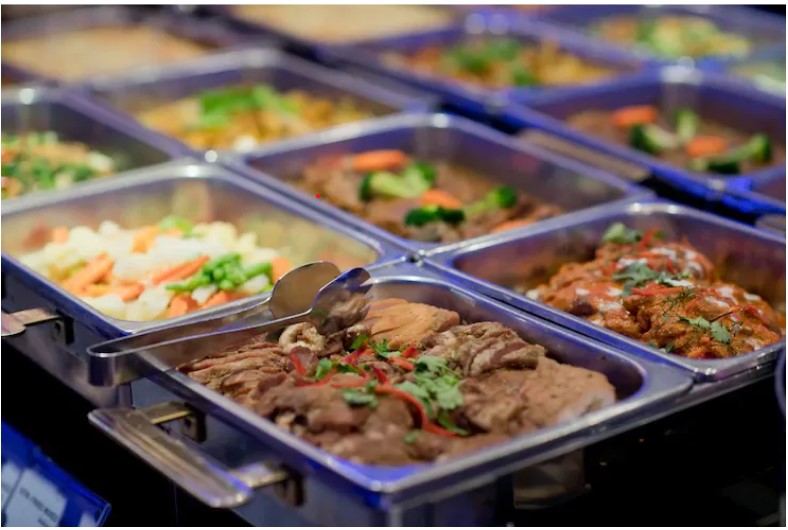Introduction
Food is often the most important part of any event as it brings people together. Caterers, home-based businesses, vending machines, and food vendors offer ready-to-eat food for guests to enjoy during such events. Many of us also lovingly prepare a feast when we host large gatherings. The food is often prepared through bulk cooking ahead of time, due to the large number of portions required.

Buffet catering photo created by jiboom - www.freepik.com
Why is bulk cooking riskier?
During bulk cooking, heat from the heat source may not be evenly distributed in the food, risking food not being thoroughly cooked or warmed enough before consumption.
Conversely, when large amounts of food need to be chilled, heat that is trapped deep in the food does not escape fast enough to cool down the food quickly. This can lead to bacterial growth even when the food has been kept in a chiller. Therefore, cooking and keeping food in large portions can often cause the food to remain at the
"temperature danger zone (5°C-60°C)" before consumption, letting food-borne pathogens thrive. For bulking cooking in particular,
Clostridium perfringens is the most common cause of food poisoning.
As bulk cooking involves large quantity of food, poor hygiene practices and the lack of kitchen space also increases the risk of cross contamination between raw and cooked food.
How does Clostridium perfringens enter food?
C. perfringens is found mainly in the environment, such as from soil, water, and the intestines of animals. The bacteria can be introduced into the kitchen through the improper handling of raw meat resulting in contaminated raw food or not washing vegetables before cooking.
Also known as “the cafeteria bacteria”, the most common foods associated with C. perfringens include undercooked meat and poultry, thickened sauces (i.e., gravies, curries), pre-cooked foods, especially spiced and herbed dishes that are held at temperature of below 60°C for approximately 2 hours before consumption.
Eating food contaminated with
C. perfringens can lead to food poisoning. This bacterium releases a toxin in the small intestine which causes diarrhoea and stomach cramps. While no one is spared from getting food poisoning from
C. perfringens, vulnerable groups like young children, pregnant women, the elderly and immunocompromised can get seriously ill.
What can food industry and consumers do to ensure the food is safe to eat?
Food safety is a joint responsibility of the government, the food industry, and consumers.
SFA conducts regular inspections and sampling to ensure the cooked food sold in local food establishments is safe and comply with the standards in the Singapore Food Regulations. For example, local food establishments are required to have a clean kitchen and equipment, adequate cooling, and refrigeration facilities for large-scale service. Non-compliances could contribute to bacteria contamination.
Local caterers are also required to put in place a food safety management system to systematically identify, prevent, and reduce food-borne hazards (e.g., pest control programme, appointment of a food hygiene officer, segregated area for processing raw food and cooked food).
While food handlers play an important role in ensuring the safety of pre-cooked food, we can do our part as consumers and home cooks to ensure that the food prepared in bulk is safe to eat. Consumers should observe the following good food safety practices:
When looking for catering options:
When handling catered food or preparing your own food:
-
Wash your hands with soap and dry them before preparing and eating food.
-
Keep your kitchen and equipment clean to prevent contamination.
-
Ensure that food is cooked thoroughly and serve the food immediately if you can.
-
Segregate the preparation of raw produce and cooked food to prevent cross-contamination.
-
Keep the food out of the temperature danger zone (5°C-60°C) if you are not serving or eating them soon. Refrigerate the food immediately or keep it warm at 60°C or higher.
-
Divide large pots of food, such as soups and stews, and large cuts of meats, such as roasts, into small quantities and shallower containers for refrigeration. This helps food cool quickly enough to prevent bacteria from growing (Tip: Do not overcrowd your fridge as this prevents cool air circulation).
-
C. perfringens can also contaminate raw fruits and vegetables, so it is important to wash all produce under water before preparation.
-
Temperature of the fridge should be kept at 4°C or colder.
-
Leftovers should also be eaten within 3-4 days (or within 1 day for vulnerable people).
About the Author
Dr Adeline Yong is a Scientist from the Risk Assessment and Communications Department of the National Centre for Food Science. With a PhD in Public health Microbiology from Nanyang Technological University, Dr Yong is responsible for microbiological risk assessments and safety assessments of Novel Foods derived from biomass and precision fermentation. She is also a proud parent of one daughter and was an educator for general science.